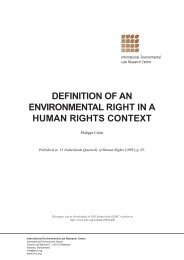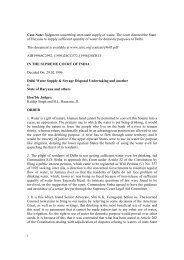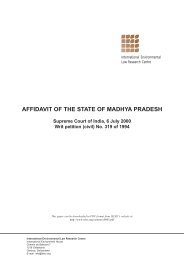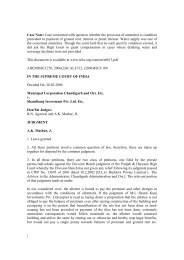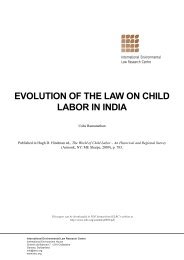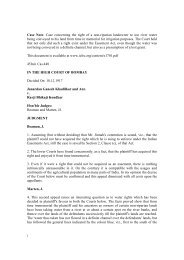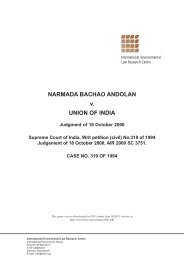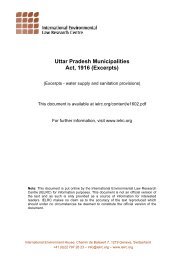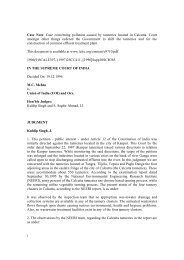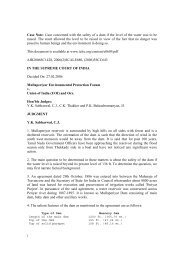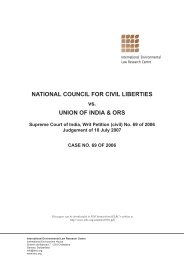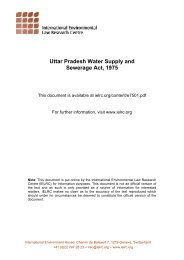Liability and Redress under the Cartagena Protocol - International ...
Liability and Redress under the Cartagena Protocol - International ...
Liability and Redress under the Cartagena Protocol - International ...
Create successful ePaper yourself
Turn your PDF publications into a flip-book with our unique Google optimized e-Paper software.
d) Drawbacks of negligence principlesThe concept of negligence presents a difficulty in enforcing liability <strong>and</strong> redress for biotechnology activitiesbecause of <strong>the</strong> locus st<strong>and</strong>i requirements <strong>and</strong> <strong>the</strong> time limits. On <strong>the</strong> one h<strong>and</strong>, <strong>the</strong> plaintiff has to prove that<strong>the</strong> defendant, over <strong>and</strong> above <strong>the</strong> general public, owed him a duty of care. On <strong>the</strong> o<strong>the</strong>r h<strong>and</strong>, being a tort, anaction accruing from it must statutorily be filed within 3 years from <strong>the</strong> date of occurrence. The requirement offoreseeability was also identified as one of <strong>the</strong> major issues that make <strong>the</strong> concept of negligence inappropriatewhile attaching liability <strong>and</strong> redress to activities involving GMOs. This is associated with lack of knowledge<strong>and</strong> <strong>the</strong>refore foreseeability.For <strong>the</strong> common law negligence principles to provide an effective liability <strong>and</strong> redress regime for biotechnologyactivities, <strong>the</strong>re needs to be training courses organised for policy makers, judges <strong>and</strong> <strong>the</strong> general publicabout <strong>the</strong> nature <strong>and</strong> potential adverse effects of LMOs.2. Rule in Ryl<strong>and</strong>s vs FletcherThis rule applies to anything brought on l<strong>and</strong> in <strong>the</strong> course of its non-natural use, that is likely to do mischiefon escape. Damage <strong>and</strong> escape need not be reasonably foreseeable. This concept was found to be weak becauseit contemplates natural users of l<strong>and</strong> thus limiting its application to industrial <strong>and</strong> pollution activity on l<strong>and</strong>. Italso alienates damage caused by GMOs since GMOs by <strong>the</strong>ir nature are not “things” on l<strong>and</strong>. In case <strong>the</strong> conceptis to be utilised in apportioning <strong>and</strong> attaching liability, <strong>the</strong>n it will only be used in instances where <strong>the</strong>rewas a deliberate act of introducing GMOs on l<strong>and</strong>. Overall, it offers weak protection to litigants.3. NuisanceIt was defined as an act or omission, which is an interference with, disturbance of or annoyance of a personin enjoyment or exercise of a right belonging to him as a member of <strong>the</strong> public, his ownership/occupation orenjoyment of his l<strong>and</strong>, easement or profit or o<strong>the</strong>r use connected with l<strong>and</strong>. This tort was found to be weak <strong>and</strong>inappropriate since it is only utilised when <strong>the</strong> damage extends to a neighbour or interferes with <strong>the</strong>ir comfortableenjoyment of l<strong>and</strong>.B. Disadvantages of Common Law in GMO <strong>Liability</strong> <strong>and</strong> <strong>Redress</strong>As outlined above, <strong>the</strong> common law may offer a suitable liability <strong>and</strong> redress regime but it has a number oflimitations. First, <strong>the</strong> common law’s conception of rights is quite narrow. A broader conception of rights willthus be necessary if <strong>the</strong> law of torts is to provide an effective liability <strong>and</strong> redress regime for <strong>the</strong> use of LMOs.It is encouraging that courts throughout <strong>the</strong> Commonwealth have over <strong>the</strong> years relaxed <strong>the</strong>ir locus st<strong>and</strong>i requirements.But <strong>the</strong>re is still a need to retrain judges so that <strong>the</strong>y may see beyond common law rights. Classactions would be a good way to go but <strong>the</strong>re is limited experience where <strong>the</strong> loss or damage is by impairmentor to <strong>the</strong> environment.The common law works best where <strong>the</strong>re is a good flow of information. Unfortunately, <strong>the</strong> international intellectualproperty regime has restricted it. For example, <strong>the</strong> protection of processes through patents limits <strong>the</strong>flow of technical information about biotechnology products. As a result, <strong>the</strong> amount of information availableto operators, regulators, courts <strong>and</strong> <strong>the</strong> general public is not sufficient. In <strong>the</strong> context of <strong>the</strong> tort of negligence,this makes it difficult for courts to effectively apply <strong>the</strong> tests of foreseeability <strong>and</strong> reasonableness. Additionally,common law systems require effective law reporting. Unfortunately, law reporting has not been given <strong>the</strong> appropriateattention in developing countries, such as Kenya <strong>and</strong> Ug<strong>and</strong>a.In conclusion, while <strong>the</strong>re is need to adopt new technology crucial for development especially in modernisationof agriculture, it is imperative to have a system in place to assess <strong>and</strong> manage risks present in biotechnology.In this regard, East African states should participate in <strong>the</strong> <strong>Cartagena</strong> <strong>Protocol</strong> discussions on liability <strong>and</strong>redress.10



